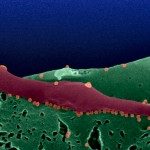Link to Pubmed [PMID] – 24922573
Cell Host Microbe 2014 Jun;15(6):706-16
The high replication and mutation rates of RNA viruses can result in the emergence of new epidemic variants. Thus, the ability to follow host-specific evolutionary trajectories of viruses is essential to predict and prevent epidemics. By studying the spatial and temporal evolution of chikungunya virus during natural transmission between mosquitoes and mammals, we have identified viral evolutionary intermediates prior to emergence. Analysis of virus populations at anatomical barriers revealed that the mosquito midgut and salivary gland pose population bottlenecks. By focusing on virus subpopulations in the saliva of multiple mosquito strains, we recapitulated the emergence of a recent epidemic strain of chikungunya and identified E1 glycoprotein mutations with potential to emerge in the future. These mutations confer fitness advantages in mosquito and mammalian hosts by altering virion stability and fusogenic activity. Thus, virus evolutionary trajectories can be predicted and studied in the short term before new variants displace currently circulating strains.


